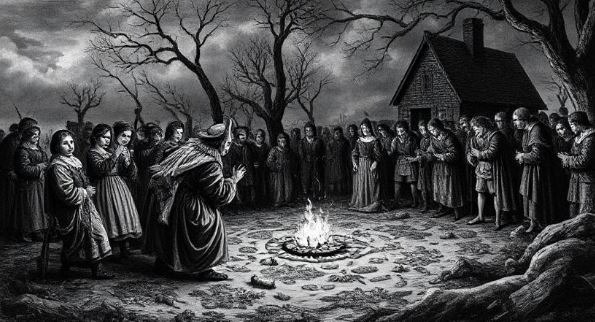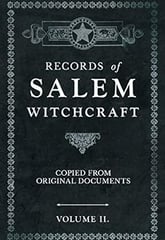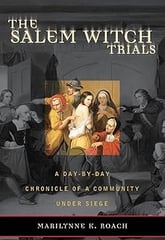Reflecting on the Legacy of the Salem Witch Trials
A Historical Remembrance 1962
WITCHES
Lily
3/1/20259 min read


Introduction to the Salem Witch Trials
The Salem Witch Trials, which took place between 1692 and 1693, represent a significant and tumultuous period in American colonial history. This dark chapter unfolded in and around Salem Village, now known as Danvers, Massachusetts, and was driven by a complex interplay of social, political, and religious factors prevalent in late 17th-century New England. The era was marked by a prevailing belief in the supernatural, combined with a deep-rooted fear of the unknown that permeated the Puritan community.
At this time, Massachusetts was a colony influenced largely by Puritanism, a religious movement that emphasized strict moral conduct and a belief in the devil's active presence in everyday life. The Puritans viewed witchcraft as a grave sin, leading to a heightened anxiety regarding spiritual purity and the safety of their society against perceived malevolent forces. Tensions were exacerbated by various external factors, including ongoing conflicts with Indigenous peoples, political instability due to colonial governance, and economic hardship. Such conditions created a fertile ground for fear and paranoia to fester within the community.
The trials began in the context of a series of mysterious ailments afflicting several young girls in Salem Village, which were quickly attributed to witchcraft. The initial accusations led to a frenzy of hysteria, as individuals feared for their safety and sought to protect their families at all costs. This resulted in widespread accusations against various community members, many of whom were marginalized or held unpopular views. Consequently, the popular belief in witchcraft intensified, and the legal proceedings that followed saw both the erosion of due process and the emergence of a climate of distrust and scapegoating.
The Salem Witch Trials remind us of the perilous consequences that obsession with superstition and societal fear can unleash. As we delve deeper into this period, it becomes crucial to comprehend these underlying factors to better appreciate the tragic events that unfolded in Salem Village and beyond.
Key Figures in the Trials
The Salem Witch Trials, which transpired between 1692 and 1693 in colonial Massachusetts, involved numerous key figures whose actions and contributions significantly influenced the unfolding of these tragic events. Among the most notable was Reverend Samuel Parris, the minister of Salem Village. Parris played a pivotal role in escalating the witchcraft hysteria, particularly due to his authoritative position in the community. His daughter, Betty Parris, along with his niece, Abigail Williams, were among the first young girls to exhibit strange behaviors that sparked the initial accusations. Their claims of witchcraft set in motion a chain of events that ultimately led to the deaths of many innocent individuals.
Another significant figure in this tumultuous period was Tituba, an enslaved woman from Barbados. As one of the first women accused of practicing witchcraft, Tituba’s confession under duress ignited rampant fears and fueled the accusations against others. Her testimony not only highlighted the pervasive distrust in the society but also reflected the racial and social dynamics at play during the trials.
The trials also saw the involvement of several other young girls who played crucial roles in disseminating the initial accusations. Notable among these were Ann Putnam Jr. and Mercy Lewis, whose testimonies against various townspeople amplified the witch hunt frenzy. On the other end of the spectrum, many women were unjustly accused and executed, such as Rebecca Nurse, a respected member of the community, and Elizabeth Proctor, the wife of John Proctor. These women, among others, became emblematic of the tragedy's broader implications. Through their lives and misfortunes, the trials exposed the darker aspects of human nature, social tensions, and the consequences of unchecked hysteria in a community.
The Accusation Process
The Salem Witch Trials, which transpired between 1692 and 1693 in colonial Massachusetts, were marked not only by the nature of the accusations but also by the procedural framework that upheld them. At the core of the hysteria was the mechanism of accusation, often initiated by individual claims of experiencing witchcraft. Many of the accusers were young girls, who stated that they were tormented by certain individuals believed to be witches. Such allegations quickly gained traction, igniting a fervor of fear and paranoia within the community.
One of the critical elements of the accusation process was the reliance on spectral evidence. This form of evidence allowed accusers to claim that an apparition or specter of the accused had caused them harm. The court deemed this type of evidence credible, despite its inherently unverifiable nature. Because of the subjective basis of spectral evidence, it fostered an environment where mere suspicion could lead to grave consequences for the accused. The legal framework of the trials, rooted in English common law, lacked the safeguards necessary to protect individuals from wrongful accusations, thus further compounding the crisis.
The frenzy surrounding the trials effectively perpetuated itself. Once a person was accused, a chain reaction began, leading to further accusations and investigations. The societal climate of fear created a perfect storm where communities were eager to find a scapegoat for the myriad problems they faced, be it illness, misfortune, or unexplained phenomena. This atmosphere of mistrust propagated rampant accusations, engulfing not only individuals but also families, friends, and neighbors, ultimately tearing apart the fabric of the community. The consequences were dire, leading to wrongful imprisonments and executions, which highlighted the devastating potential of unchecked paranoia amidst a community under duress.
The Trials and Executions
The Salem Witch Trials, which took place in 1692, comprised a series of hearings and prosecutions of individuals accused of witchcraft in colonial Massachusetts. Central to these proceedings were the court trials that resulted in the execution of twenty people, predominantly women. The hysteria that enveloped Salem Village fueled a relentless pursuit of alleged witches, leading to extreme measures by the local authorities.
During the trials, the court relied heavily on spectral evidence, which was testimony based on dreams and visions rather than concrete evidence. This form of evidence was deemed acceptable by judges, resulting in sensational testimonies that implicated numerous individuals. One of the most notable figures was Rebecca Nurse, an esteemed community member, who was accused despite her reputation. Her trial featured testimonies that questioned the integrity of the evidence presented. Ultimately, she was convicted and hanged, exemplifying how societal pressures and fear overwhelmed justice.
Among those executed, several names stand out, including Sarah Good, an impoverished woman who had long been an outcast in her community. She faced accusations driven by personal vendettas, leading to her execution in early July 1692. Another tragic figure was Elizabeth Proctor, who was also convicted and hanged, despite her efforts to defend herself. Her case illustrates the dire consequences faced by women who dared to speak out against the rising tide of witchcraft allegations.
The trials culminated with the execution of Anna O. Warren and others, who were solely victims of mass hysteria and fear. Each execution marked a bleak milestone in Salem's history, as families were torn apart and lives irreparably damaged. These trials serve as a stark reminder of the dangers of scapegoating and unfounded accusations that can arise in times of communal fear.
Public Reaction and Impact on Society
The Salem Witch Trials, which occurred between 1692 and 1693, elicited intense public reaction and had profound implications on societal norms and legal practices in colonial America. Initially, the prevailing atmosphere was one of fear and paranoia, fueled by societal and political uncertainties. Community members were quick to accuse their neighbors of witchcraft, resulting in a powerful wave of hysteria that swept through Salem and beyond. This phenomenon underscores how quickly communal ties can fray under the pressure of fear, as friendships and familial bonds deteriorated amidst suspicions and accusations.
In the midst of the trials, public sentiment swung aggressively towards condemnation of the accused. In a atmosphere rife with superstition and religious fervor, many townsfolk believed in the necessity of eradicating evil, leading to numerous wrongful convictions and executions. However, as the trials progressed, skepticism began to grow. Prominent figures, such as Increase Mather and his son Cotton Mather, expressed concern regarding the reliability of spectral evidence and the overall judicial process. These voices of dissent marked a pivotal shift in public opinion, as people started to question the legitimacy of the accusations that once seemed so compelling.
The repercussions of the Salem Witch Trials extended far beyond their immediate conclusion. The aftermath prompted a reevaluation of witchcraft accusations and shaped future legal practices, ultimately contributing to a more evidence-based judicial system. Over time, community attitudes towards witchcraft began to soften, allowing for legal reforms that emphasized the protection of individual rights. The trials also emerged as a cautionary tale that warned subsequent generations about the dangers of mass hysteria, reflecting a societal evolution towards reason and justice. This critical reflection resonates in contemporary discussions surrounding due process and the moral imperatives of justice.
Legacy of the Salem Witch Trials
The Salem Witch Trials, which took place in 1692, have left an indelible mark on American culture and the judicial system. The trials not only showcased the dangers of mass hysteria but also serve as a cautionary tale that echoes through literature, film, and various forms of popular culture. One significant depiction is Arthur Miller's play "The Crucible," which parallels the witch trials with the 1950s McCarthy era, emphasizing the broader theme of scapegoating and fear-driven persecution. Such references highlight the trials' ongoing relevance in discussions about societal fears leading to unjust actions.
In contemporary discourse, the Salem Witch Trials serve as a poignant reminder of the importance of justice and due process. The denial of fair trials and the reliance on spectral evidence during these events have prompted critical reflections on the American legal system. Many scholars and commentators argue that the legacy of the trials underscores the necessity for safeguarding individual rights, particularly during times of crisis when panic can overshadow rational judgment.
The historical lessons drawn from the Salem events are crucial, especially in understanding modern "witch hunts" or moral panics. Whether discussing contemporary issues of scapegoating in public opinion or the rush to judgment in social media contexts, the implications of the Salem Witch Trials reverberate. They shed light on how unchecked fears can fuel a culture of intolerance and injustice, making it imperative for society to remain vigilant against similar occurrences. Thus, the Salem Witch Trials remain a critical study point for both cultural and judicial exploration, compelling us to consider how past mistakes can inform present and future conduct. This legacy remains integral to discussions around the protection of civil liberties and the cautious balance between societal security and individual rights.
Conclusion: Lessons from History
The Salem Witch Trials represent a significant and troubling episode in American history, one that illuminates the perilous consequences of fear-driven hysteria. This dark chapter serves as a powerful reminder of how societal panic can lead to the scapegoating of the most vulnerable individuals within a community. The intense atmosphere of suspicion and distrust that permeated Salem in the late 17th century ultimately resulted in tragic injustices, including the execution of innocent men and women. As we reflect on these events, it becomes apparent that the lessons derived from the Salem Witch Trials extend far beyond that time and place.
Firstly, the trials underscore the critical need for a foundation of trust and open communication within communities. When social cohesion deteriorates, it creates fertile ground for misinformation and fear to flourish, potentially leading to the persecution of individuals based on unfounded accusations. Furthermore, the trials illustrate the risks associated with unchecked authority and the importance of safeguarding individual rights. History has shown that when power is concentrated without accountability, the potential for abuse and injustice increases significantly.
As we examine the implications of the Salem Witch Trials for contemporary society, we are reminded of the necessity for vigilance against similar injustices. By understanding how fear can distort judgment and erode community bonds, we are better equipped to recognize and combat the emergence of similar patterns in our own time. Ultimately, acknowledging such historical events fosters a critical dialogue about ethics, justice, and the responsibilities of individuals and societies alike. Through this reflection, we aspire to honor those who suffered during the Salem Witch Trials by ensuring that their plight informs our present and shapes a more equitable future.
LINKS
The Salem Witch Trials: A Day-by-Day Chronicle of a Community Under Siege
As an Amazon Associate I earn from qualifying purchases.
Records of the Salem Witch-Hunt
As an Amazon Associate I earn from qualifying purchases.
In the Shadow of Salem: The Andover Witch Hunt of 1692 Hardcover – June 14, 2018
As an Amazon Associate I earn from qualifying purchases.
Andover Witchcraft Genealogy: Volume 1 in the “Salem Witchcraft” series Paperback – October 7, 2013
As an Amazon Associate I earn from qualifying purchases.
Salem Witch Trials: A History from Beginning to End Paperback – Large Print, January 20, 2023
As an Amazon Associate I earn from qualifying purchases.
The Salem Witch Hunt: A Brief History with Documents (Bedford Series in History and Culture) Second Edition
As an Amazon Associate I earn from qualifying purchases.
As an Amazon Associate I earn from qualifying purchases.
As an Amazon Associate I earn from qualifying purchases.
Magick
Explore the enchanting realm of Witchcraft today.
©Lilyopatra 2025. All rights reserved.
All SALES ARE FINAL, and we appreciate your understanding of our site policy. Once a purchase is made, we cannot offer refunds or exchanges for any items. This policy ensures that we can maintain low prices and high-quality products for our customers. We encourage you to thoroughly review product descriptions, sizes, and specifications before completing your purchase to avoid any dissatisfaction. If you have any questions about an item, please reach out to our customer service team prior to ordering. We value your business and are committed to providing a positive shopping experience, but once a transaction is finalized, we are unable to accommodate any changes or returns.
Thank you for your cooperation and support.





